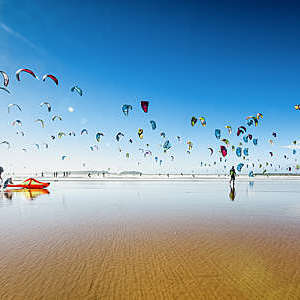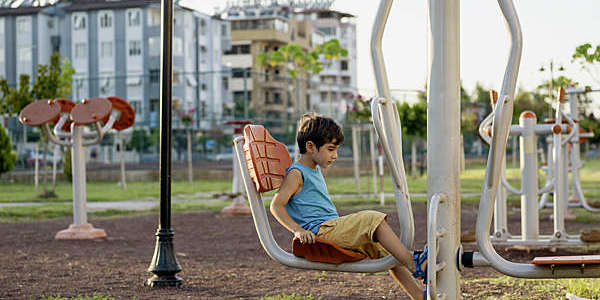Looking after our own and each other’s health and well-being has never been more important. Commuting remains an essential part of our everyday lives and offers us an efficient way to increase physical activity daily. Luckily, electrically power-assisted cycles, or EPACs, are on the rise – paving the way for us to do just that. Here’s everything you need to know about this technology and how ISO helps ensure that we pedal towards wellness in the safest way possible.
All set for summer sports


After the long winter, getting outside and moving around is a great way to stay healthy and enjoy the warmer weather. But summer is also peak time for outdoor sports injuries. Here’s how ISO’s technical committee for sports and other leisure pursuits keeps you safe and active in the sun.
Summertime means time off work and more opportunity for leisure, which provides not only the break you need but the chance to get outdoors, have fun and improve your health. The World Health Organization (WHO) says that a lack of physical exercise is one of the leading risk factors for conditions such as heart disease, cancer and diabetes. Its findings also reveal that 25 % of adults are not getting enough exercise, rising to 80 % in teenagers.
Studies have shown that regular outdoor activities have significant benefits for health. WHO states that the benefits of being physically active far outweigh the risks of accident or injury and can improve muscular and cardiorespiratory fitness, improve bone strength, increase energy and help with weight control. Brain health improves too. In 2018, British medical journal The Lancet published a study on over 1.2 million Americans that found that exercise provided a noticeable improvement to mental health, thereby reducing treatment expenditure from 12 % to 22 %.
The arrival of summer is an excellent time to take stock of the safety standards that can help you maximize the fun of your favourite sports while preventing serious injuries. On an international level, these standards are developed by ISO’s technical committee ISO/TC 83, Sports and other recreational facilities and equipment, which sets the basic safety requirements for protective equipment and sporting facilities. So, with summer now upon us and statistics encouraging us to get outside and move, it’s good to know ISO has got you covered.

Exercise provides a noticeable improvement to mental health.
Fitness in the park
Tai chi is a good introduction to exercising outdoors and was developed in China many centuries ago. It can involve martial arts and competitive wrestling, but for most people, it is undertaken with slow and deliberate movements to help focus on breathing, meditation and balance.

The Chinese Wushu Association says that practising tai chi takes up little space. “The best place should be in a beautiful outdoor environment, with fresh air, which is in line with the concept of ‘nature and harmony’ advocated by the principles of tai chi,” says a staff member of the association.
There are a growing number of studies that suggest that tai chi can help people of all abilities and ages improve their body flexibility, nervous system, immunity, digestive and cardiovascular systems. It can also prevent and relieve symptoms relating to depression, Alzheimer’s and Parkinson’s disease and is widely used in sports rehabilitation and recovery from surgery.
If you want more from tai chi than stretching and relaxation, you can graduate to using swords as well. The Chinese Wushu Association has worked with ISO/TC 83’s subcommittee SC 6, Martial arts, to develop a standard – ISO 20740 – on the Wushu Taiji sword used in the martial arts area of tai chi. With specifications on the materials used and dimensions of the hilt, blade and hand guard, greater user safety and consistent product quality can be ensured for anybody interested in going beyond bare-handed tai chi exercises. However, don’t forget that you must have mastered the basics of tai chi first.
Clothing, too, is subject to an ISO standard. Designed with manufacturers in mind, ISO 20739 specifies the classifications, requirements and test methods of clothing for performing the Wushu Taiji sport. “The clothing is made in accordance with the traditional Chinese folk clothing style and is mandatory for formal competitions or performances. It embodies people’s respect for tai chi and recognition of our culture,” the Wushu Association explains.

In at the deep end
Moving from the park to the water, for many people, holidays feature swimming. To ensure poolside safety, computer vision systems are available and in wide use by public swimming pools or pools that are larger than 150 m2. ISO 20380, Public swimming pools – Computer vision systems for the detection of drowning accidents in swimming pools – Safety requirements and test methods, covers the safety requirements and methods needed to continuously scan pools, mathematically detect a solid mass at the bottom of the pool and activate an alarm, saving precious time.
ISO/TC 83 developed this standard to help lifeguards prevent drowning and accidents in public pools. “Our studies have shown that due to architectural designs, organization issues or personnel restraints, lifeguards alone are not always enough to prevent accidental drowning,” committee member Joanna Laurent says. Even with the computer vision system in place, vigilance by not only trained lifeguards but parents remains vital. “This system is only to be used by appropriately trained experts and cannot be the only safety precaution taken,” she says.
“With data showing that drowning occurs despite the presence of lifeguards, it is important that swimmers have received appropriate lessons and parents are always on hand to keep an eye on their children. No system is perfect and enhancing safety by every means available will always be essential.”
Floating safe
With safety in mind, swimming will always be a highlight of outdoor summer play and exercise. Novelty inflatables have become increasingly popular in recent years with shapes, designs and purposes expanding beyond life jackets and paddling pools. They all aim to enhance the fun to be had in or on the water but can present a heightened risk of accidents or drownings.
Known as “floating leisure articles for use on and in the water”, ISO has developed seven individual standards, under the ISO 25649 series, that cover the equirements for safety in design, use, stability and load capacity. “It’s important that we examine an inflatable item made for the water and do a very thorough examination to find out every possible risk associated with it,” says Enrico Ticozzi, another expert member of ISO/TC 83.
“A risk analysis allows us to ensure that each item is made to rigid technical standards so that users can feel assured that the product they’re using – anything from an inflatable arm band for their child, a blow-up ride-on llama or a canoe – is safe for them to use.”
To ensure that the inflatable meets these ISO requirements, each item has the standards printed on the packaging of the product and the product itself. “They are very visible. It might ruin the graphics of some of the designs but they are unmissable. You should avoid buying inflatables from casual sellers at the beach and instead go to your regular retailers or online to get the quality and compliance required by ISO,” advises Ticozzi.
With safety in mind, swimming will always be a highlight of outdoor summer play and exercise.


Studies have shown that regular outdoor activities have significant benefits for health.
Top-notch gear
If riding a large floating llama isn’t exciting enough, maybe kiteboarding is the summer sport for you. This water sport is an extreme blend of surfing, windsurfing and paragliding and uses a board harnessed to a large hand-controlled kite to ride across the water. Kiteboarding is a relatively new sport, gaining popularity after the first competition was held in Hawaii in 1998, and is planned to debut at the Olympic Games in Paris in 2024.

© Christophe Bureau
Not surprisingly, however, a new sport creates new hazards and the rapid rise of kiteboarding saw people suffer from hundreds of accidents due to equipment failure and weak release systems. ISO/TC 83 published ISO 21853, Kiteboarding – Release system – Safety requirements and test methods, to specify the minimum standards needed for a release system that safely reduces the pulling force of the kite and a quick-release system that immediately disconnects the user from the kite.
Jörgen Vogt of the Global Kitesports Association was part of the team that developed this standard. “It’s a hugely exciting sport, but it’s still regarded as an extreme sport as there are risks associated with speed, water and variable weather conditions. Although modern kiteboarding equipment is very safe to use when you know how, kites can develop enormous amounts of power and, when handled incorrectly, can be very dangerous,” he says.
Enrolling on a course with a fully qualified instructor is the best way to start, Vogt recommends. New kiteboarders need to be educated on safety systems and correct techniques and should start by learning how to fly a small kite on land first. “When you are properly trained, kiteboarding is a sport that can be enjoyed by men, women, children and people with disabilities. In a short period of time, anyone can learn to safely kiteboard and enjoy an invigorating outdoor experience.”
There are many more options for getting outside into the fresh air and making the most of your summer. If you’re still looking for safe-but-fun ideas on how to spend your time exercising, ISO also has standards on stepping machines, sleeping bags and tennis rackets.
And when the sun finally withdraws its cheering beams, winter sports are also under ISO’s watchful eye. So, if you’re looking to get fit at any season, there will always be a safe and fun activity for you.
Wellness
Our well-being issue provides wellness tips, looks into the benefits of sport and e-bike standards, discusses medical spas and thalassotherapy and provides you with loads of insights in the booming medical tourism industry.
/en/2020/ISOfocus_141/ISOfocus_141.jpg/thumbnails/300)



